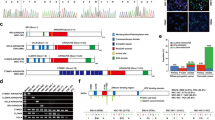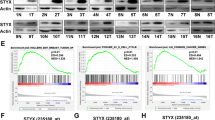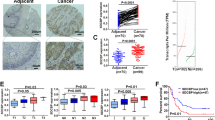Abstract
During the analysis of phosphotyrosine-containing proteins in scirrhous gastric carcinoma cell lines, we observed an unusual expression of Arf-GAP with Rho-GAP domain, ankyrin repeat and PH domain 3 (ARAP3), a multimodular signaling protein that is a substrate of Src family kinases. Unlike other phosphotyrosine proteins, such as CUB domain-containing protein 1 (CDCP1) and Homo sapiens chromosome 9 open reading frame 10/oxidative stress-associated Src activator (C9orf10/Ossa), which are overexpressed and hyperphosphorylated in scirrhous gastric carcinoma cell lines, ARAP3 was underexpressed in cancerous human gastric tissues. In this study, we found that overexpression of ARAP3 in the scirrhous gastric carcinoma cell lines significantly reduced peritoneal dissemination. In vitro studies also showed that ARAP3 regulated cell attachment to the extracellular matrix, as well as invasive activities. These effects were suppressed by mutations in the Rho-GTPase-activating protein (GAP) domain or in the C-terminal two tyrosine residues that are phosphorylated by Src. Thus, the expression and phosphorylation state of ARAP3 may affect the invasiveness of cancer by modulating cell adhesion and motility. Our results suggest that ARAP3 is a unique Src substrate that suppresses peritoneal dissemination of scirrhous gastric carcinoma cells.
This is a preview of subscription content, access via your institution
Access options
Subscribe to this journal
Receive 50 print issues and online access
$259.00 per year
only $5.18 per issue
Buy this article
- Purchase on Springer Link
- Instant access to full article PDF
Prices may be subject to local taxes which are calculated during checkout








Similar content being viewed by others
References
Brown MT, Cooper JA . (1996). Regulation, substrates and functions of src. Biochem Biophys Acta 1287: 121–149.
Carragher NO, Frame MC . (2004). Focal adhesion and actin dynamics: a place where kinases and proteases meet to promote invasion. Trends Cell Biol 14: 241–249.
Carramusa L, Ballestrem C, Zilberman Y, Bershadsky AD . (2007). Mammalian diaphanous-related formin Dia1 controls the organization of E-cadherin-mediated cell-cell junctions. J Cell Sci 120: 3870–3882.
Chen TJ, Gehler S, Shaw AE, Bamburg JR, Letourneau PC . (2006). Cdc42 participates in the regulation of ADF/cofilin and retinal growth cone filopodia by brain derived neurotrophic factor. J Neurobiol 66: 103–114.
Daniele T, Di Tullio G, Santoro M, Turacchio G, De Matteis MA . (2008). ARAP1 regulates EGF receptor trafficking and signalling. Traffic 9: 2221–2235.
Faix J, Grosse R . (2006). Staying in shape with formins. Dev Cell 10: 693–706.
Frame MC . (2002). Src in cancer: deregulation and consequences for cell behaviour. Biochim Biophys Acta 1602: 114–130.
Huveneers S, Danen EH . (2009). Adhesion signaling—crosstalk between integrins, Src and Rho. J Cell Sci 122: 1059–1069.
I ST, Nie Z, Stewart A, Najdovska M, Hall NE, He H et al. (2004). ARAP3 is transiently tyrosine phosphorylated in cells attaching to fibronectin and inhibits cell spreading in a RhoGAP-dependent manner. J Cell Sci 117: 6071–6084.
Itoh K, Yoshioka K, Akedo H, Uehata M, Ishizaki T, Narumiya S . (1999). An essential part for Rho-associated kinase in the transcellular invasion of tumor cells. Nat Med 5: 221–225.
Kim HS, Bae CD, Park J . (2010). Glutamate receptor-mediated phosphorylation of ezrin/radixin/moesin proteins is implicated in filopodial protrusion of primary cultured hippocampal neuronal cells. J Neurochem 113: 1565–1576.
Kowanetz K, Husnjak K, Holler D, Kowanetz M, Soubeyran P, Hirsch D et al. (2004). CIN85 associates with multiple effectors controlling intracellular trafficking of epidermal growth factor receptors. Mol Biol Cell 15: 3155–3166.
Krugmann S, Anderson KE, Ridley SH, Risso N, McGregor A, Coadwell J et al. (2002). Identification of ARAP3, a novel PI3K effector regulating both Arf and Rho GTPases, by selective capture on phosphoinositide affinity matrices. Mol Cell 9: 95–108.
Krugmann S, Andrews S, Stephens L, Hawkins PT . (2006). ARAP3 is essential for formation of lamellipodia after growth factor stimulation. J Cell Sci 119: 425–432.
Krugmann S, Williams R, Stephens L, Hawkins PT . (2004). ARAP3 is a PI3K- and rap-regulated GAP for RhoA. Curr Biol 14: 1380–1384.
Matsuoka T, Hirakawa K, Chung YS, Yashiro M, Nishimura S, Sawada T et al. (1998). Adhesion polypeptides are useful for the prevention of peritoneal dissemination of gastric cancer. Clin Exp Metastasis 16: 381–388.
Nishimura S, Chung YS, Yashiro M, Inoue T, Sowa M . (1996). Role of alpha 2 beta 1- and alpha 3 beta 1-integrin in the peritoneal implantation of scirrhous gastric carcinoma. Br J Cancer 74: 1406–1412.
Raaijmakers JH, Deneubourg L, Rehmann H, de Koning J, Zhang Z, Krugmann S et al. (2007). The PI3K effector Arap3 interacts with the PI(3,4,5)P3 phosphatase SHIP2 in a SAM domain-dependent manner. Cell Signal 19: 1249–1257.
Sarmiento C, Wang W, Dovas A, Yamaguchi H, Sidani M, El-Sibai M et al. (2008). WASP family members and formin proteins coordinate regulation of cell protrusions in carcinoma cells. J Cell Biol 180: 1245–1260.
Tanaka M, Sasaki K, Kamata R, Hoshino Y, Yanagihara K, Sakai R . (2009). A novel RNA-binding protein, Ossa/C9orf10, regulates activity of Src kinases to protect cells from oxidative stress-induced apoptosis. Mol Cell Biol 29: 402–413.
Uekita T, Tanaka M, Takigahira M, Miyazawa Y, Nakanishi Y, Kanai Y et al. (2008). CUB-domain-containing protein 1 regulates peritoneal dissemination of gastric scirrhous carcinoma. Am J Pathol 172: 1729–1739.
Yanagihara K, Takigahira M, Tanaka H, Komatsu T, Fukumoto H, Koizumi F et al. (2005). Development and biological analysis of peritoneal metastasis mouse models for human scirrhous stomach cancer. Cancer Sci 96: 323–332.
Yeatman TJ . (2004). A renaissance for SRC. Nat Rev Cancer 4: 470–480.
Yoon HY, Lee JS, Randazzo PA . (2008). ARAP1 regulates endocytosis of EGFR. Traffic 9: 2236–2252.
Acknowledgements
The pEGFP-ARAP3 plasmid was a kind gift from Krugmann S (Cambridge, UK). This work was supported by a Grant-in-Aid for Cancer Research and by a Grant-in-Aid for Scientific Research from the Ministry of Education, Culture, Science and Technology of Japan for the Third Term Comprehensive 10-Year Strategy for Cancer Control.
Author information
Authors and Affiliations
Corresponding author
Ethics declarations
Competing interests
The authors declare no conflict of interest.
Additional information
Supplementary Information accompanies the paper on the Oncogene website
Rights and permissions
About this article
Cite this article
Yagi, R., Tanaka, M., Sasaki, K. et al. ARAP3 inhibits peritoneal dissemination of scirrhous gastric carcinoma cells by regulating cell adhesion and invasion. Oncogene 30, 1413–1421 (2011). https://doi.org/10.1038/onc.2010.522
Received:
Revised:
Accepted:
Published:
Issue Date:
DOI: https://doi.org/10.1038/onc.2010.522



